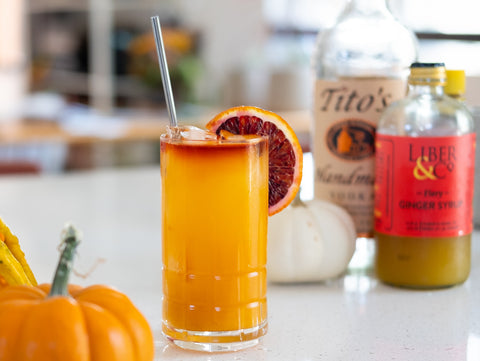There are 3 reasons for a garnish: smell, taste and appearance. As long as you’re accomplishing at least one of those, you’re garnishing correctly, but here are a few ingredient-specific tricks that will up your garnish game!
Citrus: The most common garnish is citrus. Lime wheels on your margarita, lemon wedges on gin and soda, orange half moons on your Painkiller, lime shells on a Mai Tai, Orange peels in your Old Fashioned, Lemon swaths on your Martini.
With wheel, wedges, moons or anything with both skin and fruit, you can expect that the juice is being added to the drink or the fruit will be eaten. Use these garnishes when a bite of fruit would compliment the drink, or the drinker might want a little more acidity!

The aroma of a citrus skin will make a lasting difference on the smell of a drink. All of the sweet citrus oils live on the outside of the skin, while the bitter oils live in the white pith. When using a shell, swath or twist, you’re trying to utilize those sweet oils. To make a swath or a twist you’re going to need a peeler. Most professionals are using a Y-peeler. A y-style peeler is going to leave the most oils in the skin while giving you the widest swath. You can choose to trim your peels if visuals are important to you! My personal favorite move for a citrus peel is cutting a slit in the middle of the peel, lengthwise, to I can attach it to the glass and it won’t fall out or float around. If you’re not using a peeler, you’re probably using a knife or channel knife. Both of these methods usually result in a lot of pith, which results in a lot of bitter oils. No matter what you’re using to cut the fruit, be sure to express with the skin facing the drink and the pith facing you. This is important not only when expressing the oils, but also when placing the peel in the drink.

Sometimes the bitterness of the peel is too overpowering for a drink. That’s a good time to express and discard. Not all cocktails need a visual garnish. A manicured peel can express a high end and elegant experience, while a lime shell and fresh citrus feels summery and tropical. There’s really no limit, and once you think you’ve done everything listed here, try zesting or dehydrating. Play a little with your citrus. If you’re using some citrus juice in your cocktail, might as well use the whole fruit.
Herbs and Leaves: Fresh herbs and flowers always make a drink look fresh. Mint is the most common, but any edible green will work well. The herbs on the top of your drink will often be more powerful than anything muddled in your drink, 90% of taste comes from smell, so garnish plentifully. The hardest part with herbs is getting them to remain fresh. No one likes wilted herbs on top of their drink. Every herb is different, but a good rule is prepping herbs as soon as possible. Hearty herbs (rosemary) can usually survive in a cool environment with their ends in water. The following process works well for non-delicate herbs, like mint and thai basil.

1. Pick the leaves off the lower parts of the stem. A sprig should have 2-4 levels of leaves with a long stem.
2. In a sealable container, gather all your herb leaves. Before sealing, add a damp paper towel or napkin to keep the moisture in the container without letting them brown too quickly. These are great for muddling or making syrups.
3. Gather your stems. With a sharp blade, cut last ¼” inch off the end of the stem.
4. In a separate container, fill 2/3 with ice (crushed is ideal) and water. Place the stem into the water, ideally leaving the leaves dry. Store in a cool place.
This will allow the herbs to last at least a week if not two! More delicate herbs (cilantro, shiso, etc) might need a little more attention to detail. Temperature humidity and position will all make a difference. As long as your herb looks lively, garnish away. And just like your citrus, consider utilizing every part of the herb! You can make an herb simple by soaking a standard simple syrup with the stems and small leaves, or blending them together.

Fruit: Fruit is pretty straight forward and everyone loves a cocktail cherry.
It’s good to know that they’re technically not part of the old fashioned recipe, but do what makes you happy. You will often find berries, melon or tropical fruit on a cocktail as well. With fruit, try to either spear it with a pick, slit it and place it on the edge of the glass. With a crushed ice drink you can place the fruit into the top of the drink. Fruit is expected to be eaten, so whatever you can do to make that process easier is great. If the fruit is supposed to be floating in the drink (Think muddled berries in a buck or bramble, or balls of melon in a gin and tonic) maybe include a stir spoon or straw. Just like with citrus, the possibilities are endless, as long as the flavor profile of the cocktail is complimented by fruit...


